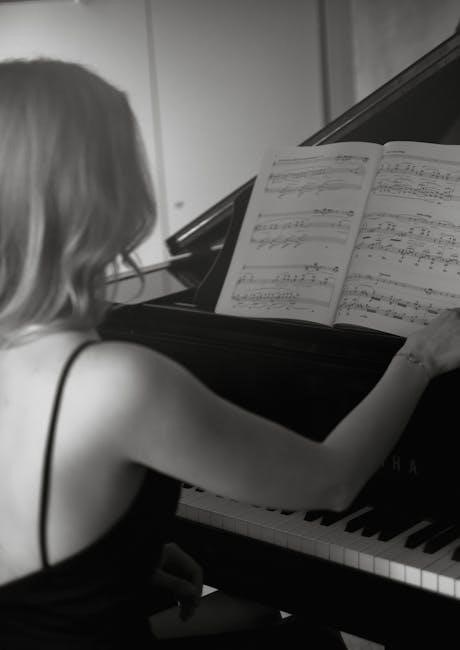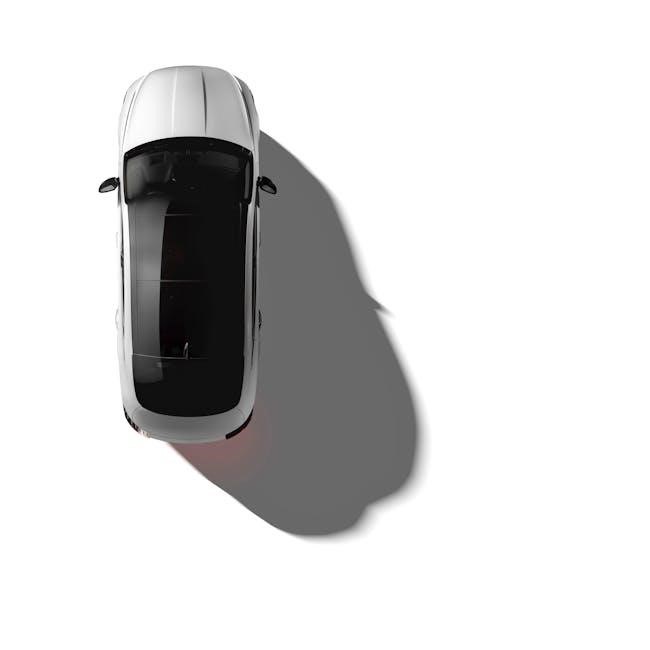Beethoven’s Piano Sonata No. 8 in C minor, Op. 13, known as the Pathetique Sonata, is a profound work of emotional intensity and technical brilliance, composed in 1798.
Overview of the Sonata
Beethoven’s Piano Sonata No. 8 in C minor, Op. 13, known as the Pathetique Sonata, was composed in 1798 and dedicated to Prince Karl von Lichnowsky. It is renowned for its dramatic contrasts and emotional depth, showcasing Beethoven’s innovative approach to sonata form. The work consists of three movements: the dramatic Grave ‒ Allegro di molto e con brio, the lyrical Adagio cantabile, and the lively Rondo: Allegro. The sonata is celebrated for its technical challenges and profound expressiveness, making it a cornerstone of classical piano repertoire and a testament to Beethoven’s compositional genius.
Historical Background and Composition
Beethoven’s Pathetique Sonata was composed in 1798, a pivotal time in his career, and dedicated to his patron, Prince Karl von Lichnowsky. The sonata was published in 1799 and marked a significant shift in Beethoven’s compositional style, showcasing his growing emotional intensity and technical innovation. Written in C minor, a key often associated with tragic and profound emotions, the sonata reflects Beethoven’s personal struggles and artistic evolution. Its dramatic contrasts and expressive depth set it apart from earlier classical sonatas, establishing it as a landmark work in piano literature. The name “Pathetique” was not Beethoven’s choice but aptly captures its emotional essence.

Structure and Movements of the Pathetique Sonata
The Pathetique Sonata consists of three movements: the dramatic first movement, a lyrical second movement, and a lively rondo finale, showcasing Beethoven’s mastery of contrasts and form.
First Movement: Grave ‒ Allegro di molto e con brio
The first movement of Beethoven’s Pathetique Sonata opens with a solemn Grave section, marked by dramatic, ominous chords that set a tragic tone. This introduction transitions into the Allegro di molto e con brio, a fiery and virtuosic segment characterized by rapid arpeggios, sharp dynamic contrasts, and a relentless energy. The movement’s emotional depth is underscored by its structural complexity, blending dramatic outbursts with moments of lyrical beauty. Pianists face significant technical challenges, including intricate fingerwork and precise control of tempo and dynamics, making this movement a true test of skill and interpretative ability.
Second Movement: Adagio cantabile
The second movement, Adagio cantabile, is a lyrical and deeply expressive slow movement that contrasts sharply with the first movement’s intensity. It features a beautiful, singing melody accompanied by arpeggiated chords, creating a sense of calm and introspection. This movement is often praised for its emotional depth and poetic qualities, making it a favorite among pianists and audiences alike. The slower tempo allows for nuanced phrasing and dynamic control, enabling performers to convey the music’s inherent pathos. Despite its simplicity, the Adagio cantabile requires a refined touch and sensitivity to fully capture its elegance and emotional resonance.
Third Movement: Rondo: Allegro
The third movement, Rondo: Allegro, concludes the sonata with a lively and dynamic rondo form, showcasing Beethoven’s mastery of classical structure. The recurring theme alternates with contrasting episodes, creating a sense of playfulness and energy. Technically demanding, the movement requires precision and agility, particularly in the rapid passagework and dramatic crescendos. Despite its virtuosic challenges, the Allegro maintains a light, almost humorous character, providing a stark contrast to the sonata’s darker moments. Its brisk tempo and rhythmic drive make it a thrilling conclusion to the Pathetique Sonata, leaving a lasting impression on the listener.

Key Features and Emotional Depth
The Pathetique Sonata showcases Beethoven’s mastery of emotional expression, blending intense technical challenges with profound feeling. Its dramatic contrasts and deeply personal melodies create a powerful, moving experience.
The Use of C Minor and Its Emotional Significance
Beethoven’s choice of C minor for the Pathetique Sonata underscores its tragic and deeply expressive nature. This key, often associated with intensity and emotional turmoil, perfectly captures the sonata’s dramatic contrasts and personal depth; The somber, reflective qualities of C minor allow for a profound exploration of human emotion, from the ominous opening chords to the poignant melodies. This harmonic foundation enhances the work’s emotional resonance, creating a sense of pathos that has captivated listeners for centuries. The use of C minor is central to the sonata’s enduring appeal and its reputation as one of Beethoven’s most moving compositions.
Technical Challenges for Pianists
Beethoven’s Pathetique Sonata presents significant technical challenges for pianists. The dramatic shifts in dynamics, intricate fingerings, and arpeggio passages demand exceptional dexterity and control. The Allegro movement, with its rapid arpeggios and octave scales, pushes pianists to their limits, requiring precise timing and stamina. Additionally, the expressive nuances and dynamic contrasts, such as the sudden fortissimo chords, necessitate a deep understanding of phrasing and emotional delivery. These technical demands make the Pathetique Sonata a true test of skill and artistry, ensuring its reputation as one of the most challenging and rewarding works in the piano repertoire.

Sheet Music and PDF Availability
Beethoven’s Pathetique Sonata is widely available as free PDF downloads from platforms like MutopiaProject.org and other digital libraries, offering easy access for pianists of all skill levels.
Free PDF Downloads from MutopiaProject.org
MutopiaProject.org offers free PDF downloads of Beethoven’s Pathetique Sonata, providing high-quality sheet music for pianists. The scores are meticulously typeset using LilyPond, ensuring clarity and accuracy. Pianists can access both the full sonata and individual movements, such as the iconic Adagio cantabile. These downloads are free to distribute, modify, and perform, making them an excellent resource for musicians of all levels. The PDFs are easily downloadable, allowing pianists to practice and perform this masterpiece without cost or restriction. MutopiaProject.org is a trusted source for classical music enthusiasts seeking accessible and reliable sheet music.
Commercial Sheet Music Options
For those seeking high-quality, professionally edited sheet music, commercial options for Beethoven’s Pathetique Sonata are available from reputable publishers like Edition Peters. These editions often include expert annotations, fingerings, and historical context, enhancing both study and performance. Additionally, some commercial versions offer companion CDs or MIDI files for practice accompaniment. Pianists can choose from urtext editions, which remain faithful to the original manuscript, or performance editions tailored for specific skill levels. Commercial sheet music ensures durability and clarity, making it a valuable investment for serious musicians seeking precise and reliable scores of this beloved sonata.

Performance and Interpretation
Beethoven’s Pathetique Sonata is renowned for its emotional depth and technical demands, offering pianists a canvas for expressive interpretation. Performers often emphasize the dramatic contrasts between movements, balancing the tragic gravity of the Grave with the lyrical beauty of the Adagio and the virtuosic energy of the Rondo. Interpretations vary widely, from slower, introspective tempos to more dynamic, impassioned renderings, each bringing unique insights to Beethoven’s masterpiece.
Notable Recordings and Pianists
The Pathetique Sonata has been interpreted by countless pianists, each bringing unique emotional depth. Notable recordings include those by pianists like Tatiana Nikolayeva and Lawrence Hiung, whose performances highlight the sonata’s dramatic contrasts. Their renditions are available in both PDF and MIDI formats, offering listeners and pianists alike the chance to study and appreciate the work’s nuances. These recordings, along with others, showcase the sonata’s enduring appeal and the interpretive freedom it affords, making it a cornerstone of classical piano repertoire accessible through various platforms like MutopiaProject.org and other music libraries.
Modern Interpretations and Arrangements
The Pathetique Sonata continues to inspire modern interpretations, with pianists and arrangers offering fresh perspectives. Some recordings feature slower tempos to emphasize emotional depth, while others incorporate orchestral arrangements or electronic elements. These adaptations highlight the sonata’s versatility and enduring relevance. Additionally, the availability of free PDF downloads from platforms like MutopiaProject.org has made the sheet music accessible to a broader audience, encouraging new interpretations and performances. These modern takes ensure the sonata remains a vibrant part of contemporary classical music, bridging tradition and innovation for future generations of musicians and enthusiasts.

Cultural Impact and Legacy
The Pathetique Sonata has left an indelible mark on classical music, influencing countless composers and remaining a cornerstone of piano repertoire. Its emotional depth continues to inspire generations, solidifying Beethoven’s legacy as a visionary composer.
Popular Culture References
Beethoven’s Pathetique Sonata has been widely referenced in popular culture, appearing in films, TV shows, and commercials. Its emotional depth and dramatic contrasts make it a favorite for soundtracks. The sonata has been featured in movies like Fur Elise and The Pianist, as well as in video games and literary works. Its iconic second movement, Adagio cantabile, is often used to evoke melancholy or introspection. The sonata’s themes have also inspired modern arrangements and covers, ensuring its relevance across generations. Its presence in media underscores its enduring impact and ability to resonate with diverse audiences.
Influence on Later Composers
Beethoven’s Pathetique Sonata profoundly influenced later composers, setting a new standard for emotional intensity and harmonic innovation. Brahms and Liszt drew inspiration from its dramatic contrasts and technical demands. Liszt, in particular, created transcriptions of the sonata, highlighting its adaptability and enduring appeal. Chopin, while maintaining his own delicate style, was influenced by the sonata’s expressive depth and technical challenges. The sonata’s use of C minor and its tragic, emotive qualities inspired Romantic-era composers to explore similar themes. Its legacy continues to resonate, shaping the works of countless musicians and remaining a cornerstone of classical music repertoire.

Learning and Educational Resources
Learning Beethoven’s Pathetique Sonata is supported by free PDF downloads from MutopiaProject.org and other platforms, offering sheet music and educational materials for pianists of all levels to study and perform.
Beginner-Friendly Versions
Beginners can explore simplified arrangements of Beethoven’s Pathetique Sonata through free PDF downloads from platforms like MutopiaProject.org. These versions maintain the sonata’s emotional depth while reducing technical complexity, making it accessible for early learners. Easy/Level 5 piano scores are available, offering a gradual introduction to the piece’s iconic movements. Additionally, many websites provide step-by-step guides and practice materials, allowing pianists to master sections at their own pace. These resources are ideal for building confidence and skill before tackling the original composition, ensuring a smooth transition to more advanced interpretations.
Advanced Study Materials
Advanced pianists can delve into detailed scores and analytical resources for Beethoven’s Pathetique Sonata, available as PDF downloads from platforms like MutopiaProject;org. These materials offer in-depth exploration of the sonata’s complexities, including harmonic analysis and performance insights. Scores with fingerings and interpretive notes provide guidance for mastering technical challenges, such as the dramatic Grave and Allegro movements. Additionally, resources focusing on phrasing, dynamics, and Beethoven’s expressive markings enable musicians to refine their interpretations. These advanced study materials are invaluable for pianists seeking to deliver authentic and nuanced performances of this iconic work, maintaining its emotional and technical brilliance.
Beethoven’s Pathetique Sonata remains a cornerstone of piano repertoire, offering profound emotional depth and technical challenges. Its availability in PDF format from sources like MutopiaProject.org ensures accessibility for study and performance. Exploring this sonata through both historical context and modern interpretations provides a richer understanding of its significance. Pianists and enthusiasts are encouraged to delve into advanced study materials, recordings, and analyses to fully appreciate its complexity. Whether for performance or appreciation, the Pathetique Sonata continues to inspire, embodying Beethoven’s genius and enduring legacy in classical music.